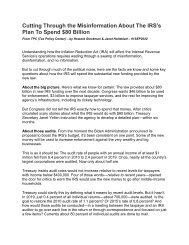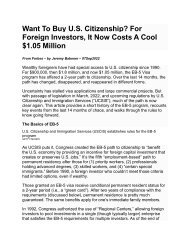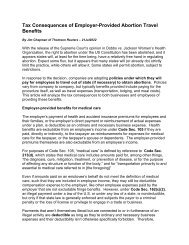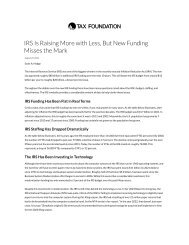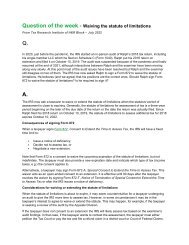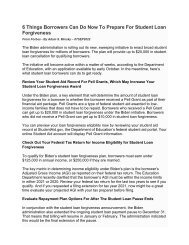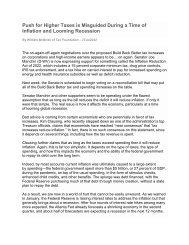Handbook-Divorce and taxes
You also want an ePaper? Increase the reach of your titles
YUMPU automatically turns print PDFs into web optimized ePapers that Google loves.
<strong>Divorce</strong> <strong>and</strong> <strong>taxes</strong>: Dividing retirement savings<br />
when love hurts<br />
When retirement plan assets are divided after a divorce, <strong>taxes</strong> can hurt. Learn how qualied<br />
domestic orders <strong>and</strong> post-divorce property transfers can help.<br />
By: Alison Flores / February 13, 2020<br />
Dividing assets in a divorce is a complicated nancial issue. Retirement plan assets <strong>and</strong> the family home<br />
often represent some of the most valuable assets a couple owns. Splitting these assets can be<br />
contentious <strong>and</strong> involve attorneys, nancial planners, <strong>and</strong> tax advisors. The tax implications of dividing<br />
retirement plan savings because of divorce can be complicated <strong>and</strong> vary based on the kind of property<br />
the former spouse receives.<br />
Qualied domestic relations order (QDRO) for employer<br />
retirement plans<br />
If a plan participant simply takes a retirement distribution <strong>and</strong> writes a check to the former spouse, the<br />
plan participant will owe income <strong>taxes</strong> on the distribution (<strong>and</strong> 10% additional tax if it is an early<br />
distribution), not the former spouse. The plan participant will receive Form 1099-R <strong>and</strong> report the taxable<br />
income <strong>and</strong> any additional tax on their federal income tax return.<br />
To move the responsibilities for income <strong>and</strong> early distribution <strong>taxes</strong> to the recipient spouse, the plan<br />
participant can use a qualied domestic relations order (QDRO). A QDRO is a court order that gives rights
to an alternate payee (usually the former spouse). A QDRO species the benets to be paid to the<br />
alternate payee. A QDRO may relate to marital property rights, child support, or alimony.<br />
When a QDRO is used to transfer assets to an alternate payee who is a former spouse, the former spouse<br />
will receive Form 1099-R <strong>and</strong> report any taxable income on the distribution. The 10% additional tax on<br />
early distributions never applies when a distribution is made pursuant to a QDRO. The age of the<br />
participant <strong>and</strong> the alternate payee do not impact the original QDRO distribution. However, if the alternate<br />
payee rolls over the distribution to an IRA, a later distribution may be subject to the 10% additional tax.<br />
Because of the complexity involved in drafting a QDRO, <strong>and</strong> the differences among plan rules <strong>and</strong> payout<br />
options, it’s generally advisable to consult an attorney for assistance with a potential QDRO.<br />
In summary: transferring plan assets using a QDRO is essential to ensuring the<br />
recipient spouse is liable for tax on any retirement plan distributions they receive.<br />
Caution: Similar tax impacts can be accomplished under some plans sponsored by federal, state, or city<br />
entities <strong>and</strong> tax-exempt organizations. While these plans may not utilize the QDRO procedure, an attorney<br />
can help determine what options are available for these plans to accomplish similar results.<br />
Transferring individual retirement arrangement (IRA) assets<br />
pursuant to a divorce decree<br />
Similarly, if an IRA owner takes a distribution <strong>and</strong> simply writes a check to the former spouse in a divorce,<br />
the IRA owner will receive Form 1099-R <strong>and</strong> report the taxable income <strong>and</strong> any additional tax on their<br />
federal income tax return, not the recipient spouse.<br />
Unlike employer plans, QDROs cannot be used for IRAs. Instead, an IRA can be divided between former<br />
spouses by directly transferring assets from the original owner’s IRA to the IRA of the former spouse. The<br />
transfer must be made pursuant to a divorce decree or legal separation agreement. When this occurs, the<br />
transfer is tax-free. The recipient spouse is subject to tax on subsequent distributions. The 10% additional<br />
tax would apply to subsequent distributions if the recipient spouse is not yet 59 ½. For traditional IRAs, a<br />
recent change means required minimum distributions (RMDs) would rst be required when the recipient<br />
spouse attains age 72.<br />
If the original IRA owner had basis in any IRAs, basis for the benets transferred must be allocated to the<br />
recipient spouse. Basis should be allocated based on the value of the IRA the recipient spouse receives<br />
<strong>and</strong> the entire value of the original IRA owner’s IRAs.<br />
Rollovers to a former spouse’s IRA<br />
Former spouses may also rollover the QDRO benets to their own IRA, or may rollover from an IRA to<br />
another IRA. A rollover may be accomplished easily through a trustee-to-trustee transfer.
If a trustee-to-trustee transfer is not utilized, a rollover from a qualied plan to an IRA, or an IRA to an IRA,<br />
may only occur if the distribution is rolled over within 60 days of receipt. But because distributions not<br />
made through a trustee-to-trustee transfer are generally subject to 20% withholding, an individual<br />
attempting a rollover on their own, needs to consider how <strong>and</strong> whether they can restore withholding on<br />
the distribution with cash from another source.<br />
QDRO transfers may be more advantageous under new alimony<br />
rules<br />
A recent change in how alimony payments are treated for tax purposes may make use of QDROs more<br />
advantageous for some taxpayers than alimony. Here’s the change <strong>and</strong> its effect.<br />
For divorce decrees nalized before 2019, alimony payments are deductible by the paying spouse <strong>and</strong><br />
reported as taxable income by the recipient spouse. This is like the tax treatment of retirement plan<br />
distributions under a QDRO.<br />
For divorce decrees nalized after 2018, alimony payments are not deductible by the paying spouse, <strong>and</strong><br />
the recipient spouse does not pay <strong>taxes</strong> on alimony. Because the paying spouse is generally subject to<br />
higher tax rates than the recipient spouse, it may be advantageous to consider using a QDRO rather than<br />
alimony to shift tax liability.<br />
<strong>Divorce</strong> <strong>and</strong> social security retirement payments<br />
Social security is an important component of retirement income streams, yet cannot be divided like other<br />
types of plan assets. QDROs can’t be used to divide social security retirement payments. However,<br />
taxpayers who were married 10 years or longer may be eligible to receive benets based on their exspouse’s<br />
record after divorce. This is possible if the benets an individual is entitled to receive based on<br />
their own work are less than they would be eligible to receive based on their ex-spouse’s work. The<br />
maximum benet based on the ex-spouse’s work is equal to one-half of the ex-spouse’s full retirement<br />
amount.<br />
For more information about Social Security retirement payments based on an ex-spouse’s work, see “If<br />
You Are <strong>Divorce</strong>d” <strong>and</strong> “Benets For Your <strong>Divorce</strong>d Spouse” from the Social Security Administration.<br />
Conclusion: We can help<br />
Sometimes, love hurts. Unexpected tax bills are painful especially after the dust settles on a divorce<br />
proceeding. Taxpayers considering divorce or in the process of divorcing should work with their legal <strong>and</strong><br />
nancial team to underst<strong>and</strong> how splitting up retirement savings will impact their <strong>taxes</strong> <strong>and</strong> their<br />
retirement income stream. Not sure how divorce could impact returns? Find one of our experts to help<br />
today.<br />
Related Insights:
• Innocent spouse relief <strong>and</strong> IRS collections<br />
• How to protect one spouse’s share of a joint tax refund when the IRS can take it<br />
• QOTW: Preserve refund when one spouse owes child support<br />
Alison Flores<br />
Alison Flores, JD, is a principal tax research analyst at The Tax Institute at<br />
H&R Block. Alison specializes in the Tax Cuts <strong>and</strong> Jobs Act (TCJA) <strong>and</strong><br />
individual income tax issues.



